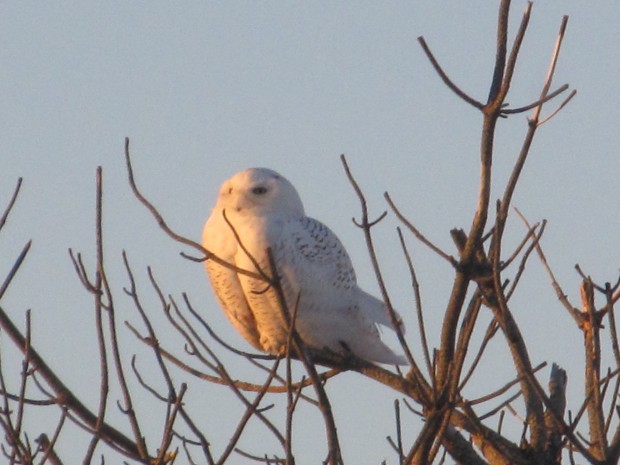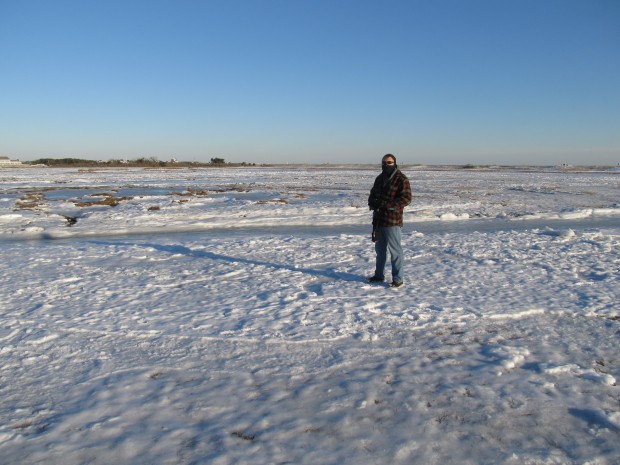Owlmania!
categories: Cocktail Hour
Comments Off on Owlmania!

Photo by Mark
Honerkamp
I decided to do this month’s blog for my OnEarth column on, you guessed it, snowy owls……
As you have no doubt heard by now, the Arctic Invasion is here.
Owlmania has swept the east coast, where one of the most beautiful, stunning, and startling of birds—the snowy owl, rarely sighted in the lower 48—has descended on us in numbers at once thrilling and puzzling. In response to this unprecedented influx of owls, an equally unprecedented number of humans have been out looking for, and at, the birds.
For me, personally, the high point came a few weeks ago when I was standing alone on Coastguard Beach on Cape Cod, on almost the exact same spot where the naturalist-writer Henry Beston lived for a year in his outermost cabin, and a young snowy rose off the tundra-like marsh with a black duck in its talons. The duck’s lifeless body hung limp, its feet dangling down like damaged landing gear. The snowy flew over the dunes, clearly wanting to be left alone with its prey. I felt something of the irritation it must have felt toward me when I saw a couple climb over from the beach and attempt to follow it. We both—owl and man—were no doubt experiencing some variant of the same thought: What are they doing on my beach, on my territory?
My irritation with the couple faded when I caught up to them. Bundled up like refugees against the cold, the man and woman were considerate, giving the owl plenty of space. They weren’t birders, didn’t even have binoculars, but they were so delighted by what they had seen that I had a hard time being grumpy. The woman’s face was radiant. (“Radiant” was a word I had found myself using a lot over the last few days, though mostly to describe the unworldly white shine of the snowy’s feathers.)
“It’s only the second time I’ve seen an owl in the wild,” she said.
She acted as if she had just witnessed a visitation, which she certainly had. I thought back to the first time I ever saw a snowy owl. Unlike this time, I hadn’t gone out in search of it. Back when I lived on Cape Cod, more than 15 years ago, I would go for daily off-season walks along the beach, and that was all I had been doing that morning. I got to the end of the sandy path that led to the open beach, and there it was. It had stared at me with black slits for eyes, the ocean wind blowing its white feathers back like a boa. It was less than ten yards away, and it apparently didn’t feel like moving, so it just sat there—looking both spectacular and perfectly at home on a beach that, on that frigid day, must have reminded it of the tundra where it summered. I stared back at it for a while, and then I walked away. For the owl it was no big deal, but for me it stands out as one of the great days of my birding life.
“They’re amazing birds,” the woman said to me.
I told her I couldn’t agree more.
We kept our eyes open for another flight up from the dunes, but eventually we all decided to give the owl a wide berth as it continued its repast of uncooked duck.
* * *
“We have the fever,” Jill Peleuses, an avid birder, told the local paper in my hometown of Wilmington, North Carolina. She was explaining why she and a friend had driven eight hours up to the Outer Banks to catch a glimpse of a snowy. Florida, North Carolina, Pennsylvania, New York, Massachusetts, Maine: the birds seem to be everywhere this winter, and are especially thick here on Cape Cod, where—thanks to a sabbatical from the university where I teach, and a generous wife—I’m spending a solitary month on a writing retreat. At West Dennis beach, one of the most popular owl-watching spots on the Cape, you don’t even have to hunt for the owl once you get to the parking lot; you just look for the line of cars. There are times when the crush is too much: when the owl lands in a nearby tree, for instance, and the hordes of photographers armed with thousand-dollar telephoto lenses start muscling each other out. While their photogenic subject—which can be remarkably tolerant of photographers when it’s not chewing on a piece of duck or other prey—may allow them to get as close as fifteen feet, it flies away when they insist on five.
But most of the people I’ve encountered have been as delighted, and as respectful, as the woman back on Coastguard Beach. And while the birds are fairly easy to find, watching them for any amount of time is something that—during these mid-winter days, at least—must be earned. That’s because the owls aren’t the only thing that has travelled down from the Arctic of late, the recent cold and snow conspiring to thin out the ranks of owl-watchers.
On my second day out on West Dennis Beach, as the first flakes fell at the start of what would soon turn into a major storm, I watched with a couple of other people as the bird alighted on a nest that an osprey had built on one of the blue boxes (used for trapping greenhead horse flies) you frequently see on the marshes here. The huge nest was decorated in the usual osprey junkyard fashion, complete with a hundred sticks, boat line, thick yarn, and a child’s fishing net jammed into its side, and it stood six feet off the ground. Up on that pedestal the owl appeared to be wearing a shining white robe, flecked with markings the color of chips on a cinnamon scone that identified it (most likely) as a female. As it swiveled its great disc of a face, it  transformed: one moment it resembled a white lion, the dashes of black on its face mere cartoon outlines of eyes and a bill; the next moment it looked decidedly more hawk-like as it lifted a hand-like talon to scratch itself; lastly, when the eyes turned entirely away, it was a featureless white dome. Mostly it just squinted there in the wind, but whenever those eyes opened they shone yellow. Amid the sere colors of the marsh, the bird’s whiteness jumped out—although the next day, with the blizzard’s help, its camouflage worked as well as it does in Arctic summers.
transformed: one moment it resembled a white lion, the dashes of black on its face mere cartoon outlines of eyes and a bill; the next moment it looked decidedly more hawk-like as it lifted a hand-like talon to scratch itself; lastly, when the eyes turned entirely away, it was a featureless white dome. Mostly it just squinted there in the wind, but whenever those eyes opened they shone yellow. Amid the sere colors of the marsh, the bird’s whiteness jumped out—although the next day, with the blizzard’s help, its camouflage worked as well as it does in Arctic summers.
Read the rest at OnEarth here: http://www.onearth.org/articles/2014/02/snowy-owls-invade-the-south

Owlin’

